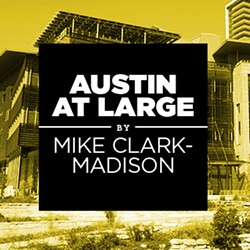Austin @ Large: Austin at Large
Field of (En)vision: for regional planning, it's a great day to go back to the future
By Mike Clark-Madison, Fri., Oct. 10, 2003

Of course, the twin crises that merged at MoPac and Slaughter -- the onslaught of big-box retail, and the relentless sprawl over the countryside and the aquifer -- are a long way from being resolved. Indeed, from a city editor's perspective, it's all sprawl, all the time. The same crises, as incarnated in the enclave of Sunset Valley, are the subject of this week's Chronicle cover story. In their way, they're also the subject of the Green Festival this weekend. And they're the subject of the insert you'll find in this issue -- detailing Envision Central Texas' long-awaited quartet of long-term growth scenarios for the five-county metro area.
Despite his latter-day role-playing as a tough-minded fiscal watchdog -- who, come budget time, proved to be less than intimidating -- Wynn's real signature issue is, or should be, regional growth management. He understands and cares about land use and urban design, not just politically but intellectually, in a way few elected leaders do. Ever since joining the City Council in 2000, Wynn has been City Hall's point man on regional cooperation -- he's heavily invested not just in ECT but other venues like CAMPO and the Greater Austin-San Antonio Corridor Council. And as Wal-Mart appears to have proved, Wynn can win on this issue, unlike the budget. If his luck holds out, he can succeed where Kirk Watson failed -- at brokering a genuine regional-growth consensus that future Wal-Marts and Endeavor Real Estate Groups can absorb and heed before making rash plans and getting the locals all excited.
Envision Consensus
Envision Central Texas kicked off with great fanfare a long time ago, in a different political era, before conservative local leaders decided that growth management was a frill that could be dispensed with in a time of economic "catastrophe." But even though the rollout of ECT's growth scenarios -- initially scheduled for this past spring -- has been delayed, the timing of the Wal-Mart war has given the ECT effort, along with the mayor, a lucky break. Retail follows rooftops. If Austin doesn't want sprawled-out big-box bullshit fouling its land and water, it needs to rethink where and how it builds new houses and new roads for new people, which is exactly what ECT is supposed to help us address.
Envision Central Texas, with its 73-member board, is aiming for a consensus vision that can be embraced, by citizens and their leaders and planners, all the way from Luling to Florence. So clearly it needs to be more circumspect than I need to be in building a case against sprawl and for political change. But ECT has nonetheless built that case. Scenario A, the long-term vision that ECT says most reflects current trends, is obviously the most horrifying, with all of Williamson Co. and most of Hays Co. (and the aquifer) disappearing under a blob of low-density rooftops. (It's this scenario that makes viable Wal-Mart's vision of a Supercenter every three miles.) Lest you think the horror here is simply aesthetic, please also note that under Scenario A, traffic congestion and travel times grow far worse, with the attendant ramifications for air quality and economic development, and the cost of infrastructure to support all the sprawl is an eye-popping $10.6 billion. Even if we wanted a ticky-tacky Central Texas, we can't afford it.
So the other three ECT scenarios are clearly preferable alternatives. Scenario B, which focuses development in corridors along new and existing roadways, would have been the status quo model if Austin's previous fitful efforts at growth management had actually been heeded; this is the vision that undergirds Austin Tomorrow, the city's decades-old but still official comprehensive plan. Back in the day, progressives thought this sort of model was itself too extreme, since it allowed under the rubric of "managed growth" things like Circle C Ranch and the Loop 360 corridor and made new highway building not only attractive but essential. But compared to what's happened since, this looks pretty damn good. Would you rather have one new SH 130, or 5 dozen new four-lane collector roads and SH 130?
Choosing a Future
ECT's Scenario C, on the other hand, would have been the status quo before the sprawl era began after World War II -- this mode of settlement, with new residents congregated in new towns that were clearly distinct from each other and from the countryside, was the only model known to the people who actually settled Central Texas. It would likely seem less radical now if the region still had a visible and viable agricultural economy, but one need only throw a rock in any American school of architecture to hit a professional planner who's made a vocation out of defending and celebrating this prewar pattern. And in civilized societies, the real estate industry has followed suit; for all the hype about the great Old World cities and their quintessential urban lifestyles, most of modern Europe actually looks like Scenario C.
Scenario D, on the other hand, reflects the intellectual romance of the ideal urban experience more than it reflects anything that actually exists anywhere. The densities it envisions, not only for Central Austin but for places like Lakeway, Georgetown, and Bee Cave, have been produced in the real world not by goals but by constraints -- the geographic limitations of landscape, the imperatives of locating infrastructure essentials (things like harbors and rail junctions and warehouse districts) where people need them, the necessities of defense in historical times, and the demand for efficiently planned and quickly built housing. We could, and maybe should, embrace a vision that calls for this much cultural change -- where we refrain from building on raw land even though nothing is stopping us and where we choose to live in multifamily housing even though we could do otherwise. But Scenario D would take Austin down a path where few regions have deigned to travel, which would obviously be much harder work.
As you can see, the survey that goes with the ECT scenarios is more refined than simply choosing between A, B, C, and D; and the final ECT vision that emerges next spring will likely reflect some mixing and matching. But it will, I predict, assuredly reject the status quo -- which even three months ago I would not have forecast with such surety. When ECT began, its assumption that Central Texas would double in population was itself seen to be a problem by certain local progressives; they wanted a strategy that would discourage such growth, not accommodate it. That was then, this is now; with the self-interested panic of land pimps echoing in the corridors of power, an anti-growth strategy is no longer viable. But with citizens finally rising up in utter disgust with their Wal-Mart nation, growth management no longer appears to be optional. ![]()
Got something to say? The Chronicle welcomes opinion pieces on any topic from the community. Submit yours now at austinchronicle.com/opinion.







